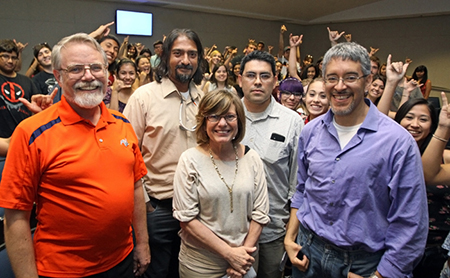By Daniel Perez
UTEP News Service
Afsaneh Hamed-Zanjani said she grew up with a fascination for science and looked forward to pursuing her interest in biology at The University of Texas at El Paso. What the incoming freshman did not expect was an invitation to participate in undergraduate research during New Student Orientation.
The El Paso native was among 60 science and engineering freshmen and transfer students who spent part of June 16 hearing about UTEP’s various undergraduate research opportunities. The focus was on a new program aimed at engaging and retaining students such as Hamed-Zanjani who are interested in science, technology, engineering and mathematics (STEM).

The Program to Educate and Retain Students in STEM Tracks (PERSIST) is a three-course freshman research sequence developed by UTEP faculty and funded with $2.4 million from the Howard Hughes Medical Institute (HHMI), a Washington, D.C.-based organization that has promoted undergraduate education for more than 25 years.
Hamed-Zanjani, a graduate of El Paso’s Loretto Academy, is a first-generation college student who applied to the PERSIST research module that will study brain mapping and connectomics, which involves the structure of the neural networks.
“I’m interested in working with the brain to find out more about people and what we’re capable of doing,” she said after three UTEP faculty members described their research during a presentation in the Bioscience Research Building. “This undergraduate research is an amazing opportunity to jump-start your career.”
The five-year program will start this fall with three University 1301 special research foundation sections, said Lourdes Echegoyen, Ph.D., director of UTEP’s Campus Office of Undergraduate Research and the PERSIST codirector. She was among the speakers during the June 16 event.
Students selected to be part of the program will be divided into three research groups of 20-25 students who will focus on chemistry and biology. The slots will be filled on a first-come, first-served basis.
The research will be lead by German Rosas-Acosta, Ph.D., associate professor of biological sciences, Arshad Khan, Ph.D., assistant professor of biological sciences, and Dino Villagran, Ph.D., assistant professor of chemistry.
Rosas-Acosta is in charge of an existing module that studies phages, viruses that attack bacteria but not humans. He will be assisted by Manuel Llano, Ph.D., associate professor of biological sciences and co-director of the Phage Lab. The Phage I study will start in the fall followed by Phage II in the spring.
Khan’s research into brain mapping and Villagran’s study of supramolecular chemistry will begin in the spring 2015 semester.
Other PERSIST team members, Eli Greenbaum, Ph.D., and Kyle Johnson, Ph.D., associate professors of biological sciences, will start their modules on genetics and forensics, respectively, in fall 2015. Future modules could add different disciplines such as physics, geology and engineering.
Incoming freshman Luis Rivera-Figueroa said he looked forward to working with Villagran to enhance his understanding of chemistry and build on his general love of science.
The recent Hanks High School graduate said he will enroll in Villagran’s University 1301 Basics of Research course this fall and then take his general chemistry class in the spring. This will lead into working in Villagran’s module of studying the synthesis of highly porous materials that can house chemical reactions.
“I like the idea of putting different compounds together to come up with something new,” Rivera-Figueroa said. His future plans include graduate school and then a management position with the U.S. Forest Service.
Stephen B. Aley, Ph.D., associate vice president for research and the HHMI grant’s principal investigator, mentioned that participation will be fun, exciting, build critical thinking skills and look good on a resume.
When the grant was announced in late May, Aley mentioned that the program was developed in part to retain more STEM students who often drop out or change majors within their first two years of higher education. PERSIST exposes them to the subject and allows them to determine their level of career interest. He and the other presenters admitted that the additional lab demands could be too rigorous for some.
“There will be extra work, but we will help them understand the advantages to being part of the program and the discoveries that they will make,” Aley said. “They’ll be working on things for which there are no known answers.”
UTEP PERSIST is modeled after a similar program at UT Austin, but this sequence is designed for UTEP’s mostly Hispanic, low-income student demographic.
UTEP is one of 37 national research universities selected from 170 applications to earn the HHMI grant. HHMI challenged the institutions to develop programs that would increase the numbers of STEM graduates, especially from underrepresented groups.
“Our nation’s research universities are absolutely critical to sustaining our scientific excellence,” said HHMI President Robert Tjian, Ph.D. “Simply put, we are challenging these universities to focus their attention on improving science education so that a greater number of talented students remain in science.”